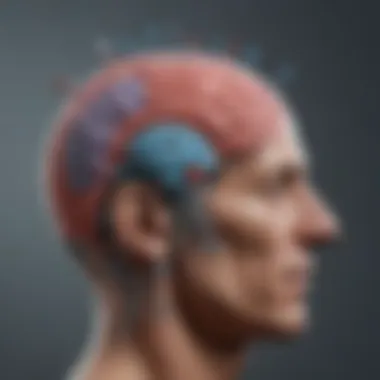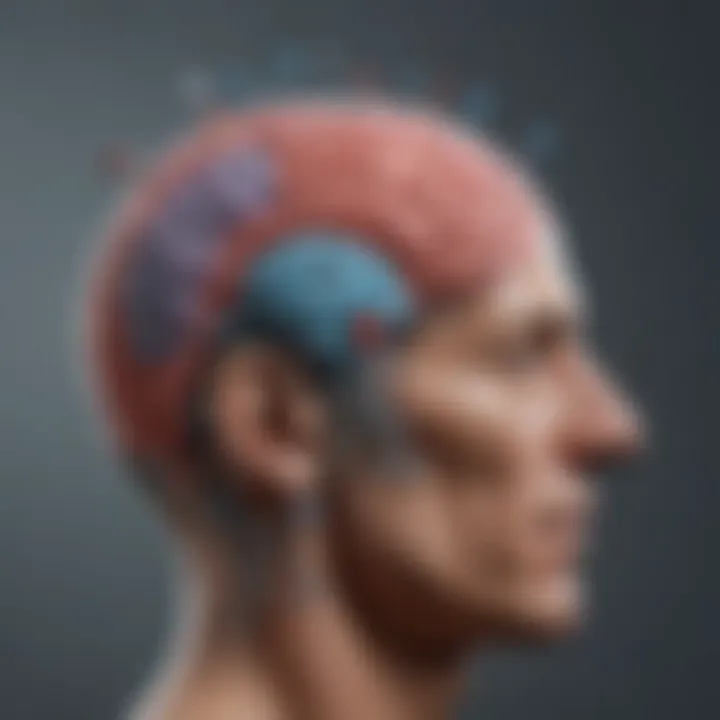Mental Health Medications and Tardive Dyskinesia Risks


Key Concepts
Definition of Primary Terms
Understanding the relationship between mental health medications and tardive dyskinesia (TD) requires clarity in defining key concepts.
Tardive Dyskinesia is a disorder characterized by involuntary, repetitive movements that often affect the face and body. It is commonly associated with long-term use of antipsychotic medications.
Antipsychotic Medications are primarily used to manage psychosis, schizophrenia, and bipolar disorder. They can be categorized into two classes: typical and atypical antipsychotics. Each class impacts the brain differently, contributing to the risk of TD.
Neurotransmitters are chemicals that transmit signals in the brain. Dopamine is particularly significant in the context of TD, as many psychotropic drugs influence its pathways.
Related Concepts and Theories
The development of tardive dyskinesia is not merely an outcome of medication use; it integrates concepts from pharmacology and neurobiology. Research indicates that TD occurs due to alterations in dopamine receptor sensitivity and long-term changes in basal ganglia function. Key theories postulate that prolonged dopamine blockade leads to compensatory upregulation of receptors, which may culminate in abnormal movements.
"The relationship between antipsychotics and tardive dyskinesia underscores the importance of understanding drug mechanisms and patient monitoring."
Clinically, this means that awareness and early recognition of TD play a critical role in mental health treatment.
Future Directions
Gaps Identified in Current Research
Despite extensive knowledge regarding TD, significant gaps remain in understanding its pathophysiology and identifying patient-specific risk factors. Many studies focus on the prevalence of TD among different demographics, but fewer analyze genetic predispositions or the effects of polypharmacy in this context. Similarly, the long-term efficacy of treatment for TD itself is still inadequate in literature.
Suggestions for Further Studies
Future research should aim to fill these gaps by investigating:
- The role of genetic markers in the susceptibility to TD.
- The impact of different combinations of mental health medications.
- The efficacy of newer agents in preventing or reversing TD.
By addressing these areas, the medical community can improve patient outcomes and enhance the overall understanding of mental health treatment dynamics.
Conducting more comprehensive studies will also foster better guidelines for clinicians in managing risks associated with psychotropic medications.
Preamble to Tardive Dyskinesia
Tardive Dyskinesia (TD) is a critical topic when discussing the impact of mental health medications. It represents a serious potential consequence of long-term use of certain pharmacological agents, particularly antipsychotics. Understanding TD is essential for both healthcare providers and patients, as it not only affects treatment decisions but also has profound implications for the quality of life. The inclusion of TD in mental health discourse highlights the necessity of balancing treatment efficacy with the risk of developing movement disorders.
Definition of Tardive Dyskinesia
Tardive Dyskinesia is characterized by involuntary, repetitive movements. These can manifest in various parts of the body, affecting facial muscles, limbs, and sometimes the torso. Movements may include grimacing, lip smacking, and jerky motions. The onset of symptoms often follows prolonged treatment with dopamine receptor antagonists, especially first-generation antipsychotics, used to manage conditions such as schizophrenia or bipolar disorder.
TD develops insidiously; individuals may not recognize its onset until it is well established. The symptoms can be distressing and can persist long after the offending medication has been discontinued, making early recognition crucial for preventing its progression.
Epidemiology of TD
The prevalence of Tardive Dyskinesia varies, but studies suggest a significant portion of patients treated with antipsychotic medications may develop it. Estimates range from 20% to 30% among those receiving treatment for prolonged periods. Various factors contribute to this wide discrepancy, including the type of medication used, duration of treatment, and individual patient characteristics.
Epidemiological studies have illustrated that older adults are at greater risk, particularly those with a history of mood disorders. Additionally, long-term treatment with first-generation antipsychotics poses a higher risk than newer alternatives. Understanding these patterns is crucial for both clinicians and patients in managing risks associated with antipsychotic therapy.
"Tardive Dyskinesia is not just a side effect; it often leads to social stigma and isolation, which can exacerbate mental health conditions."
Overview of Mental Health Medications
Understanding the landscape of mental health medications is crucial in addressing the issue of tardive dyskinesia. Medications used in mental health treatment are designed to alleviate symptoms of various disorders but can sometimes lead to significant side effects, including tardive dyskinesia. By exploring the types of these medications and their common usage, we can better assess their potential impact on patients.
Classification of Mental Health Medications


Mental health medications can be classified into several categories. Each class has a distinct mechanism of action, which influences how they impact the brain and body.
- Antipsychotics: These are primarily used for treating disorders such as schizophrenia and bipolar disorder. There are first-generation antipsychotics, which are older, and second-generation antipsychotics, which generally have fewer side effects.
- Antidepressants: These medications work primarily by altering neurotransmitter levels, addressing conditions like depression and anxiety. Selective serotonin reuptake inhibitors (SSRIs) and serotonin-norepinephrine reuptake inhibitors (SNRIs) fall into this category.
- Mood Stabilizers: Often used for bipolar disorder, these medications help stabilize mood swings. Lithium is one of the most well-known mood stabilizers.
- Anxiolytics: These are prescribed for anxiety disorders. They work by depressing the central nervous system to reduce feelings of anxiety.
- Stimulants: Commonly used to treat attention-deficit hyperactivity disorder (ADHD), stimulants can enhance focus and attention.
Each class serves a specific purpose and targets different aspects of mental health, but they also carry the risk of side effects that warrant careful consideration.
Common Usage in Mental Health Treatment
The use of mental health medications is widespread and integral to modern treatment protocols. Medications are often the first line of treatment, especially for moderate to severe cases.
- Psychiatrists typically prescribe antipsychotics to manage symptoms of schizophrenia. In the case of mood disorders, antidepressants and mood stabilizers are frequently used.
- For anxiety disorders, anxiolytics can provide immediate relief, while other medications may take time to show effectiveness.
- It is common for patients to use a combination of these medications to create a tailored treatment plan.
Despite their benefits, the potential for side effects must not be overlooked. Understanding medication classifications and their common usages helps in making informed decisions in managing risks like tardive dyskinesia, particularly in long-term treatment plans.
"The primary goal in prescribing mental health medications is to achieve a balance between alleviating symptoms and minimizing side effects."
In summary, the overview of mental health medications is essential for understanding both their therapeutic potentials and associated risks, aligning with the broader goals of patient care. This knowledge serves as a foundation for recognizing how these treatments contribute to the development of tardive dyskinesia.
Pharmacological Agents Associated with Tardive Dyskinesia
Understanding the role of pharmacological agents in the onset of tardive dyskinesia (TD) is essential. Certain medications, especially those targeting the central nervous system, have been linked to the development of this movement disorder. It is important for both clinicians and patients to recognize these connections. By identifying which medications pose a higher risk, strategies can be devised to mitigate those risks while still achieving treatment goals.
First-Generation Antipsychotics
First-generation antipsychotics, or typical antipsychotics, are among the primary contributors to the emergence of tardive dyskinesia. These medications work by blocking dopamine D2 receptors in the brain. This mechanism is effective in managing symptoms of schizophrenia and other severe mental disorders. However, prolonged use can lead to dopamine receptor supersensitivity, increasing the risk for TD.
Examples of first-generation antipsychotics include:
- Chlorpromazine
- Haloperidol
- Fluphenazine
The risk of tardive dyskinesia is generally dose-dependent, meaning higher doses increase the likelihood of this adverse effect. Awareness regarding this risk is vital for healthcare providers. Regular monitoring of patients on these medications is advisable to detect early signs of TD.
Second-Generation Antipsychotics
Second-generation antipsychotics, known as atypical antipsychotics, were introduced to reduce the risk of tardive dyskinesia. These medications, such as Risperidone, Olanzapine, and Quetiapine, have a more favorable side effect profile compared to their predecessors. They still impact dopamine receptors, but they also influence serotonin receptors.
Although these medications present a lower risk for TD when compared to first-generation agents, the risk is not completely eliminated. Some studies suggest that certain atypicals, like Risperidone, can still lead to the development of TD, particularly at higher doses or with prolonged use. Clinicians should stay vigilant even with second-generation antipsychotics, maintaining a balance between managing symptoms and minimizing the risk of movement disorders.
Antidepressants and Mood Stabilizers
Antidepressants and mood stabilizers have a varied association with tardive dyskinesia. Most commonly prescribed antidepressants include Selective Serotonin Reuptake Inhibitors (SSRIs), such as Fluoxetine and Sertraline, which are generally considered safe from causing TD. However, they may interact with other drugs that impact dopamine levels.
Mood stabilizers, especially Lithium, are used in various mood disorders. They have a more complex relationship with TD. While the connection is not as direct as with antipsychotics, any medication that alters neurotransmitter dynamics can contribute to TD, especially in the presence of other risk factors.
Monitoring and careful evaluation are advised when using these medications, particularly in vulnerable populations. Understanding the risk factors associated with each pharmacological agent is crucial for proper treatment and management.
Mechanisms Leading to Tardive Dyskinesia
Understanding the mechanisms that lead to tardive dyskinesia (TD) is crucial. This section will explore how mental health medications induce this condition. By dissecting the biological processes involved, we can gain insight into risk factors and potential preventive measures. A deep dive into TD mechanisms reveals both the physiological and pharmacological elements at play. Here, we will outline the two key areas driving these mechanisms: the role of dopamine receptors and the impact of long-term medication use.
The Role of Dopamine Receptors
Dopamine receptors are a fundamental part of the central nervous system. They are involved in many brain functions, such as mood regulation and movement control. Mental health medications, especially antipsychotics, work primarily by blocking dopamine receptors, particularly D2 receptors.
When these receptors are continuously blocked, it leads to an imbalance in dopamine neurotransmission. This alteration can cause the brain to become hypersensitive to dopamine over time. The phenomenon contributes to the manifestations of TD. Patients may exhibit unwanted movements, which can be distressing and difficult to manage.
Research has linked the degree of receptor occupancy to the risk of developing TD. Higher occupancy generally leads to a greater likelihood of TD symptoms appearing. Patients with a genetic predisposition to dopamine dysregulation may be particularly susceptible. It is essential for clinicians to assess their patients' responsiveness and adjust treatments accordingly.
Impact of Long-term Medication Use


Long-term use of certain mental health medications has been shown to have significant consequences. Prolonged exposure to antipsychotics and other related drugs can lead to persistent alterations in the way the brain processes signals associated with movement.
Chronic medication use influences neural pathways. It achieves this by causing changes in receptor density and functionality. These changes can become permanent, even after medication is discontinued. The duration of treatment is evidently a critical factor in the onset of TD.
Additionally, individual patient factors such as age, sex, and medical history can affect the degree to which long-term medication use impacts them. Older patients and those on high-dose medications may have an increased risk of developing TD.
"Long-term exposure to antipsychotics often correlates with higher risks of developing tardive dyskinesia, emphasizing the need for careful monitoring."
In summary, understanding the mechanisms behind TD allows for more informed treatment decisions. This knowledge can guide the development of strategies aimed at reducing symptoms and tailoring patient care.
Risk Factors for Developing Tardive Dyskinesia
Understanding the risk factors for developing tardive dyskinesia (TD) is crucial for anyone involved in mental health treatment. Identifying these factors can help in early detection and might mitigate the risk associated with the use of certain medications. TD can emerge in patients after prolonged treatment with antipsychotics, and its symptoms can significantly impact quality of life. Recognizing these risk factors includes examining duration of treatment, patient demographics, and coexisting medical conditions. Each of these aspects can play a significant role in the likelihood of developing this movement disorder.
Duration of Treatment
The length of time a patient is on antipsychotic medication is a critical factor in the development of tardive dyskinesia. Research indicates that prolonged exposure to these medications enhances the risk of developing TD symptoms. Those who receive treatment for extended periods often have more significant chances of presenting signs of the disorder. Typically, patients treated for more than three months with first-generation antipsychotics face higher risks than those on second-generation antipsychotics.
Key Points about Treatment Duration:
- Risk accumulation: Longer duration correlates with an increased risk.
- Initial response: Patients on effective, long-term treatment are likely to continue, which can inadvertently escalate the risk for TD.
- Monitoring needs: Clinicians must carefully monitor patients who are on long-term medication regimens.
Patient Demographics
Patient demographics such as age, gender, and ethnicity are important when considering risk factors associated with tardive dyskinesia. Older adults are particularly susceptible, as age affects the body's ability to process medications and may magnify side effects. Similarly, women show a higher tendency to develop TD compared to men, possibly due to hormonal factors that influence dopamine metabolism.
Demographic Factors to Consider:
- Age: Older patients face a higher risk of tardive dyskinesia.
- Gender: Studies suggest women are at greater risk than men.
- Ethnicity: Some ethnic groups may be more predisposed to TD due to genetic factors or varying prevalence of related conditions.
Comorbid Conditions
Comorbid medical or psychiatric conditions can also elevate the risk for developing tardive dyskinesia. Patients suffering from Parkinson’s disease or severe neurological disorders may already have movement disorders, which compounds the effects of antipsychotic medications. Additionally, those with a history of substance abuse could experience increased sensitivity to these drugs, further contributing to their vulnerability.
Comorbid Conditions that Influence TD Risk:
- Movement disorders such as Parkinson’s disease.
- Neurodegenerative conditions, which may enhance susceptibility.
- Substance abuse, potentially altering how medications are metabolized by the body.
- Mental health disorders like schizophrenia, necessitating the use of antipsychotics.
Clinical Implications and Challenges
The intersection of mental health medications and tardive dyskinesia (TD) presents a complex landscape for clinicians and patients. Understanding this relationship is essential for responsible prescribing practices and effective patient outcomes. The challenges posed by TD are not merely of a clinical nature but significantly affect the patient's emotional and psychological well-being.
Identifying Symptoms of TD
Recognizing symptoms of tardive dyskinesia is critical for timely intervention. Common indicators include repetitive, involuntary movements of the face and extremities. These may present as grimacing, lip smacking, or rapid blinking. The early identification of these symptoms allows healthcare providers to modify treatment plans before irreversible damage occurs. Regular assessments during follow-up visits can facilitate better monitoring of patients on prolonged medication. Physicians should maintain a vigilant approach, especially for those on first-generation antipsychotics, as the risk is notably higher.
Impact on Treatment Compliance
Tardive dyskinesia can significantly influence a patient’s willingness to adhere to prescribed mental health treatments. Patients may be reluctant to continue medication due to fear of developing or exacerbating TD symptoms. This behavior can have detrimental effects on their mental health stability. The perceived stigma associated with movement disorders can further complicate this issue, leading some patients to stop treatment altogether. Therefore, it is vital for healthcare providers to discuss these potential risks openly, fostering a sense of trust and understanding.
Strategies to Minimize Risk
Preventing the onset of tardive dyskinesia requires a proactive approach. Several strategies can be considered:
- Employing the lowest effective dose of medications.
- Periodically reviewing the need for continued treatment.
- Considering alternative medications with lower risk profiles, such as aripiprazole or clozapine.
- Implementing regular monitoring of movement disorders during assessments.
- Involving patients in discussions about their treatment plans to ensure they feel comfortable and informed.
Effective management and preventive strategies can significantly decrease the incidence of tardive dyskinesia among patients using mental health medications.
As we delve deeper into the nuances of tardive dyskinesia, it is clear that clinical implications intertwine closely with patient experience. Therefore, addressing these challenges collaboratively fosters a better treatment landscape.


Management Options for Tardive Dyskinesia
Effective management of tardive dyskinesia (TD) is crucial for improving the quality of life in affected individuals. This section outlines various management strategies that address both the pharmacological and non-pharmacological aspects of TD. Understanding these options helps clinicians provide tailored care while minimizing the enduring impact of this disorder on patients. The implications of these management choices are significant, as they influence not only the severity of symptoms but also the patient’s overall compliance with mental health treatment.
Medications for TD Management
Pharmacological management of TD involves various medications aimed at alleviating symptoms and enhancing patient comfort. One class of medications known in this context is VMAT2 inhibitors, such as deutetrabenazine and valbenazine. These drugs work by modulating the release of dopamine, a neurotransmitter involved in movement control.
- Deutetrabenazine: This medication helps to reduce abnormal involuntary movements by targeting the dopamine neurotransmission pathways. Studies have shown that it significantly decreases the severity of TD symptoms in many patients.
- Valbenazine: Similar to deutetrabenazine, valbenazine also focuses on diminishing the dopamine release but with a distinct dosing regimen, which can be beneficial for certain patients. This medication is specifically FDA-approved for the treatment of TD.
Aside from VMAT2 inhibitors, some clinicians may consider the off-label use of clonazepam or baclofen. Clonazepam can help manage anxiety symptoms, while baclofen addresses muscle stiffness and spasms, contributing indirectly to the control of dyskinesia. Nevertheless, using these medications should be approached cautiously, as they may bring along their own side effects.
"The choice of medication should be based on a comprehensive assessment of the patient’s symptoms, overall health, and any potential interactions with existing mental health treatments."
Non-Pharmacological Approaches
In addition to medication, non-pharmacological strategies play a significant role in managing TD. These approaches emphasize therapy, lifestyle modifications, and education to enhance overall patient well-being.
- Occupational Therapy: Engaging in tailored occupational therapy can help patients develop coping strategies for their movements. Therapists work with patients to improve daily functioning and adapt activities to reduce the impact of TD symptoms.
- Physical Therapy: Physical therapy focuses on enhancing motor function and strengthening muscles. These interventions can counter some of the physical limitations imposed by involuntary movements. Loading techniques can be implemented to help control motor activity, thereby alleviating discomfort.
- Education and Support Groups: Providing education about TD and creating awareness can empower patients and their families. Support groups offer a platform for shared experiences and coping mechanisms, reducing feelings of isolation.
- Lifestyle Changes: Certain lifestyle changes, such as regular exercise, maintaining a balanced diet, and stress management techniques, can influence overall health and potentially lessen the severity of symptoms.
In summary, a multifaceted approach that combines both medication and non-pharmacological methods is key in managing tardive dyskinesia effectively. By tailoring these strategies to individual patient needs, healthcare providers can significantly improve the patients' quality of life while addressing the complexities associated with mental health treatments.
Future Directions in Research
The exploration of the relationship between mental health medications and tardive dyskinesia (TD) is a complex and evolving field. Investigating future directions in research is essential to enhance understanding, improve patient outcomes, and minimize the risks associated with this potentially irreversible disorder. There are unique elements in this topic that provide valuable insights into the underlying mechanisms of TD and its interactions with various therapeutic strategies.
Research in this area can lead to better management strategies and innovative therapeutic options. Moreover, it helps in identifying patients at higher risk, allowing for tailored treatment plans. A multifaceted approach that integrates pharmacology, genetics, and patient demographics can yield beneficial insights.
Investigating New Therapies
The continuous search for new therapies is crucial for managing tardive dyskinesia. Traditional treatment methods, particularly the use of older antipsychotics, have raised concerns due to their association with TD. As a result, researchers are exploring alternative pharmacological agents that have a lower risk of inducing movement disorders.
New antipsychotic medications, particularly those that act primarily on serotonin receptors rather than dopamine, are being investigated. Some studies focus on compounds like pimavanserin which specifically target serotonin receptors. They show promise in reducing symptoms of TD without exacerbating movement issues. Furthermore, non-pharmacological therapies such as cognitive behavioral therapy and mindfulness practices are also being evaluated. These approaches might mitigate symptoms and improve overall patient well-being.
Understanding Genetic Predispositions
Genetic factors play a significant role in the development of tardive dyskinesia. Understanding these predispositions can lead to the identification of individuals who are more susceptible to the disorder. Research has indicated that variations in specific genes may influence how patients respond to medication. For example, polymorphisms in the DRD2 gene, which regulates dopamine receptors, could predict the likelihood of developing TD.
Currently, scientists are examining various genetic markers and their correlations with the side effects of long-term medication use. Identifying patients with a higher genetic risk profile could make it possible to customize treatment options. This tailored approach would not only help in preventing the onset of TD but also align pharmacological treatments with individual genetic makeups.
"Understanding genetic predispositions opens doors to more personalized medicine, potentially reducing the risk of tardive dyskinesia in vulnerable populations."
In summary, future research on mental health medications and tardive dyskinesia should focus on innovative therapies and genetic predispositions. These areas hold the potential to significantly advance our understanding of TD and empower clinicians and patients alike.
Finale
The conclusion is a pivotal segment of this article, focusing on synthesizing the intricate details surrounding mental health medications and tardive dyskinesia. A thorough understanding of this link is crucial for clinicians, educators, and researchers involved in mental health treatment. Summarizing the key insights allows for a clearer perspective on how long-term medication use can lead to tardive dyskinesia, emphasizing its significance in treatment planning.
By recognizing which medications are associated with increased risk and understanding the underlying mechanisms, healthcare professionals can better approach their treatment protocols. This article highlights that patient awareness is equally essential, promoting active participation in treatment decisions. Ultimately, a comprehensive grasp of these aspects not only benefits individual patients but also enhances broader mental health care strategies.
Summarizing Key Points
In succinct terms, the following points encapsulate the overall discussion:
- Tardive dyskinesia is often linked to the use of both first-generation and second-generation antipsychotics.
- Long-term use of mental health medications plays a substantial role in the development of this movement disorder.
- Risk factors include patient demographics, duration of treatment, and any comorbid conditions.
- Identifying early symptoms of tardive dyskinesia is necessary for effective intervention.
- Management strategies can be both pharmacological and non-pharmacological.
Incorporating all these elements informs a holistic approach to mental health treatment, ensuring patients receive safer care.
Emphasizing the Importance of Consultation
Consultation with healthcare professionals about mental health treatments is vital. Patients need to engage in dialogue regarding their medications and any concerns about side effects, especially regarding tardive dyskinesia. It is through open communication that individualized treatment strategies can be developed. Ensuring that healthcare providers monitor symptoms of tardive dyskinesia can lead to timely interventions, thus improving overall patient outcomes.
"The best interest of the patient is the guiding principle in mental health treatment. Understanding the risks associated with medications further enhances this interest."
By prioritizing consultation, both patients and healthcare providers can work collaboratively towards minimizing risks and addressing any symptoms as they arise.



